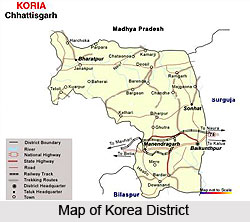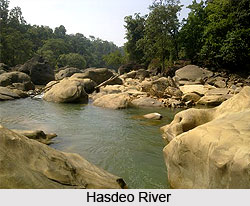 Korea is a North-West District of the Indian state of Chhattisgarh. The District came into existence on 25th May 1998 in Madhya Pradesh State. Its parent District was Surguja. After the formation of New State of Chhattisgarh on 1st November 2000, the District came under the Chhattisgarh State. The District has derived its name from the Korea State, the former princely State Korea.
Korea is a North-West District of the Indian state of Chhattisgarh. The District came into existence on 25th May 1998 in Madhya Pradesh State. Its parent District was Surguja. After the formation of New State of Chhattisgarh on 1st November 2000, the District came under the Chhattisgarh State. The District has derived its name from the Korea State, the former princely State Korea.
Korea district is bordered by Shidhi District of Madhya Pradesh on the North, Bilaspur Districts on the South, on the East by its parent Surguja District and on the West by Shahdol District of Madhya Pradesh. Koriya District lies between 22degree56` and 23degree48` North and 81degree56` and 82degree47` East. The area covered by the district is 5978 kms, of which 59.9% is forest area. The height from Sea Level is 700 metres. The general height of the lower tableland is 550 m (1800 feet) above sea level. The Sonhat Plateau has a maximum elevation of 755 m (2477 feet). The highest peak in the Deogarh District is 1027 m (3370 feet) high. The district receives an average rainfall of 1410.9 mm. The climate is mild with a bountiful monsoon, a mild summer and a bearable winter.
Resources of Korea District
Korea District has vast resources that form the basic asset of the district. The different types of resources of the district are:
Minerals of Korea District
Korea District has vast reserves of Coal. The main coal belts are in the Hasdo basin. Major deposits of these coals are in Chirimiri, Jhagrakhand, Curcha, Katkona, Pandavpara and Sonhat, Nagar, Amritdhara, Gutra, Kilhari, Pathargaon and Damuj-Labji. There are also small deposits of limestone, fire clay and red oxide in Korea District.
Drainage of Korea District
Small portion of Korea District lies in the Ganga basin and the remaining part is in the Mahanadi basin. The Ganga basin starts from the North of Sonhat beyond Mendra village and from Mendra Southward is the Mahanadi basin. The major tribute of Son is Gopad that originates about 10 miles North of Mendra village. It drains the Northern portion of the District. A major tributary of Mahanadi, Hasdo has its origin in Mendra village. The main tributaries of Hasdeo are Gej, Jhumka and Bania. The Eastern Area of the District comes in the Son basin and is drained by Gobri River which meets the Rehar in Surguja District. Gobri has its origin in the hills North of Patna.
 Forests of Korea District
Forests of Korea District
District Korea has vast range of forests. These forests play a very important role in the economy of District. There are different types of flora available in the district like Saja, Sal, Mango, Mhua, Sisham, Gamhar, Harra, Jamun, Tendu, Khair, Kusum, Imli, Bija, Aurjun, Sandan, Palas and others.
Coal Fields of Korea District
The District is very rich in Coal. The main Coal fields are as follows:
Chirimiri Coalfields: Seven main Coal mines are situated under this area. They are Chirimiri, Kurasia, N.C.P.H., Korea, Domanhill, Gelhopani (North Chirimiri) and West Chirimiri. Basically two methods are used by S.E.C.L (South Eastern Coal fields Limited under Govt. of India) for the production of coals are Open Cast and under ground Mining Systems. Grade of Coal is A and B.
Baikunthpur Coalfields: Main coal mines in this area are Charcha, Pandavpara, Katkona under the Baikunthpur coalfields.
Jhagrakhand or Hasdev Coalfields: This is another important coal mine in Korea district.
Rivers of Korea District
There are various types of rivers in Korea District that are mentioned below:
1. Hasdeo River: The Hasdo is the largest river flowing towards the South. It rises from 23degree30` North by 82degree30` East on the Sonhat Plateau and drains the South-Western part of the District. In this District, the river course resembles an upturned `S` and flows for about 95 km. After a course of about 72 km, it enters Bilaspur District at 23degree north. It receives the waters of the Gej and the Chornai on the left bank and the Tan and the Ahiran on the right before it meets the Mahanadi. The total length of the river is 245 km. The valley is narrow. Important settlements along the river are Sonhat, Ghugra, Manendragarh, Kosgain, Korba and Champa.
2. Gej River: The Gej rises from the Hills west of Central Plateau. It flows post Baikunthpur and receives the Jhink and the Atem from the left. It drains into the Mahanadi through the Hasdo. The Mand flows in the South-Eastern part of the District. Further it flows in Raigarh and Bilaspur Districts. It drains into the Mahanadi River.
3. Gopad River: The Gopad rises from the Northern slopes of Sonhat Plateau (23degree32`North, 82degree31`East) in Surguja. It flows to the North and the West in stages. In Sidhi District, the Gopad flows first to the west along the common boundary of Bharatpur Tehsil with Sidhi District. The river then meanders to the North and North-West and fina North-West and finally to the North-East. The river is joined by the Goini and the Neur in Surguja, and the Sehra, the Kandas and the Mohan in Sidhi. The stream meets the Son near Bardi.



















